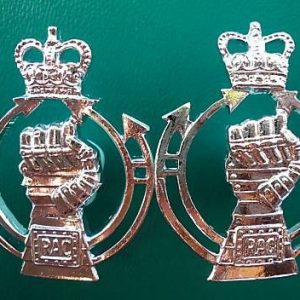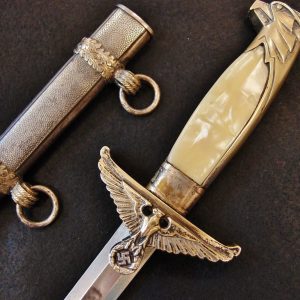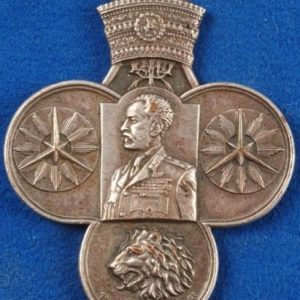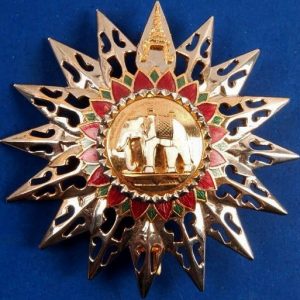SOLD
SIGNED FIRST WORLD WAR ‘WORLD OF ACES’ ‘BILLY BISHOP V.C. PHOTO AND BIOGRAPHY
Signed First World War ‘World of Aces’ ‘Billy’ Bishop V.C. photo and biography. 16.5cm x 24cm card, with ink signature to lower portion. Comes with much related paperwork, photographs, articles and two programs from the 1982 opening of the play ‘Billy Bishop Goes to War’. Air Marshal William Avery “Billy” Bishop VC, CB, DSO & Bar, MC, DFC, ED (8 February 1894 – 11 September 1956) was a Canadian flying ace and Victoria Cross recipient of the First World War. He was officially credited with 72 victories, making him the top Canadian ace of the war. During the Second World...
$450.00
SOLD
Signed First World War ‘World of Aces’ ‘Billy’ Bishop V.C. photo and biography. 16.5cm x 24cm card, with ink signature to lower portion. Comes with much related paperwork, photographs, articles and two programs from the 1982 opening of the play ‘Billy Bishop Goes to War’.
Air Marshal William Avery "Billy" Bishop VC, CB, DSO & Bar, MC, DFC, ED (8 February 1894 – 11 September 1956) was a Canadian flying ace and Victoria Cross recipient of the First World War. He was officially credited with 72 victories, making him the top Canadian ace of the war. During the Second World War, Bishop was instrumental in setting up and promoting the British Commonwealth Air Training Plan. In July 1915, whilst serving in the trenches and after watching an RFC aircraft return from a mission, Bishop said "it's clean up there! I'll bet you don't get any mud or horse shit on you up there. If you die, at least it would be a clean death." While in France in 1915 he transferred to the Royal Flying Corps. As there were no places available for pilots in the flight school, he chose to be an observer. In November 1916 after receiving his wings, Bishop was attached to No. 37 Squadron RFC at Sutton's Farm, Essex flying the BE.2c. Bishop disliked the flying at night over London, searching for German airships, and he soon requested a transfer to France. On 17 March 1917, Bishop arrived at 60 Squadron at Filescamp Farm near Arras, where he flew the Nieuport 17 fighter. At that time, the average life expectancy of a new pilot in that sector was 11 days, and German aces were shooting down British aircraft 5 to 1. Bishop's first patrol on 22 March was less than successful. He had trouble controlling his run-down aircraft, was nearly shot down by anti-aircraft fire, and became separated from his group. On 24 March, after crash landing his aircraft during a practice flight in front of General John Higgins, Bishop was ordered to return to flight school at Upavon. But before he could leave, Major Alan Scott, new commander of 60 Squadron, convinced Higgins to let him stay until a replacement arrived. The next day Bishop claimed his first victory when his was one of four Nieuports that engaged three Albatros D.III Scouts near St Leger. Bishop shot down and mortally wounded a Leutnant Theiller (although Shores (1991) has 12-kill ace Theiller as being killed vs 70 Squadron Sopwiths on 24 March; therefore this claim does not match with known losses) but his engine failed in the process. He landed in No Man's Land, 300 yards from the German front line. After running to the Allied trenches, Bishop spent the night on the ground in a rainstorm. There Bishop wrote a letter home, starting:"I am writing this from a dugout 300 yards from our front line, after the most exciting adventure of my life." General Higgins personally congratulated Bishop, and rescinded his order to return to flight school. On 30 March 1917, Bishop was named a flight commander. The next day he scored his second victory. Bishop, in addition to the usual patrols with his squadron comrades, soon flew many unofficial "lone-wolf" missions deep into enemy territory, with the blessing of Major Scott. As a result, his total of enemy aircraft shot down increased rapidly. On 8 April he scored his fifth victory and became an ace. To celebrate, Bishop's mechanic painted the aircraft's nose blue, the mark of an ace. Former 60 Squadron member Captain Albert Ball, at that time the Empire's highest scoring ace, had had a red spinner fitted. Bishop's no-hold-barred style of flying always had him "at the front of the pack," leading his pilots into battle over hostile territory. Bishop soon realized that this could eventually see him shot down; after one patrol, a mechanic counted 210 bullet holes in his aircraft. His new method of using the surprise attack proved successful; he claimed 12 aircraft in April alone, winning the Military Cross and a promotion to captain for his participation at the Battle of Vimy Ridge.
| Weight | 0.8 kg |
|---|---|
| Dimensions | 35 × 20 × 10 cm |








